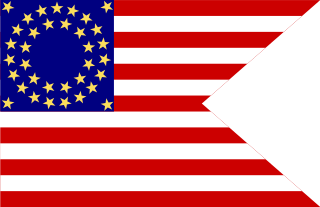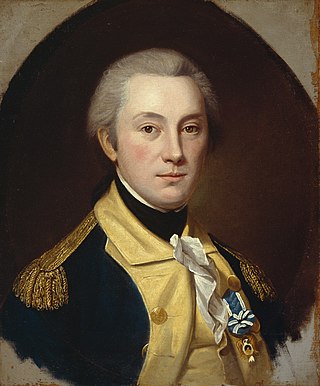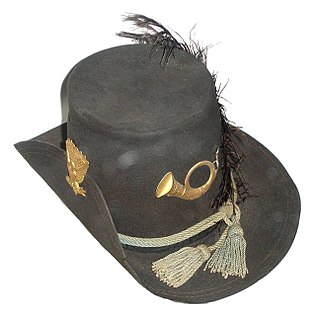
Friedrich Wilhelm August Heinrich Ferdinand von Steuben, also referred to as Baron von Steuben, was a Prussian military officer who played a leading role in the American Revolutionary War by reforming the Continental Army into a disciplined and professional fighting force. His contributions marked a significant improvement in the performance of U.S. troops, and he is consequently regarded as one of the fathers of the United States Army.

The Continental Army was the army of the United Colonies representing the Thirteen Colonies and later the United States during the American Revolutionary War. It was formed on June 14, 1775 by a resolution passed by the Second Continental Congress, meeting in Philadelphia after the war's outbreak. The Continental Army was created to coordinate military efforts of the colonies in the war against the British, who sought to maintain control over the American colonies. General George Washington was appointed commander-in-chief of the Continental Army and maintained this position throughout the war.

Marching refers to the organized, uniformed, steady walking forward in either rhythmic or route-step time; and, typically, it refers to overland movements on foot of military troops and units under field orders. Marching is often performed to march music and is typically associated with military and civilian ceremonial parades. It is a major part of military basic training in most countries and usually involves a system of drill commands.

Drill commands are generally used with a group that is marching, most often in military foot drills or in a marching band. Drill commands are usually heard in major events involving service personnel, reservists and veterans of a country's armed forces, and by extension, public security services and youth uniformed organizations.

A drill instructor is a non-commissioned officer in the armed forces, fire department, or police forces with specific duties that vary by country. Foot drill, military step, and marching are typically taught by drill instructors.

Exhibition drill is a variant of drill that involves complex marching sequences which usually deviate from drill used in the course of ordinary parades. Teams performing exhibition drill are often affiliated with military units, but the scope of exhibition drill is not limited to military drill teams. Exhibition drill is often performed by Armed Forces Precision Drill Teams, the drill teams at service academies and ROTC and JROTC units, and civilian drill teams that perform at parades, drill meets, and half-time shows and other public venues.

In the United States Armed Forces, a guidon is a military standard or flag that company/battery/troop or platoon-sized detachments carry to signify their unit designation and branch/corps affiliation or the title of the individual who carries it. A basic guidon can be rectangular, but sometimes has a triangular portion removed from the fly.

A campaign hat, sometimes called campaign cover, is a broad-brimmed felt or straw hat, with a high crown, pinched symmetrically at the four corners. The campaign hat is occasionally referred to as a Stetson, derived from its origin in the company's Boss of the Plains model in the late 19th century.

Foot drill is a part of the training regimen of organized military and paramilitary elements worldwide. "Foot drill" or "Drill" stems from time since antiquity when soldiers would march into battle, be expected to gather in a formation, and react to words of command from their commanders once the battle commenced. Much of the drill done today is either ceremonial or implemented as a core part of training in the armed forces. Though its practical application on the battlefield has faded, modern militaries justify the use of drill with the claim that it enhances military discipline, as it requires instant obedience to commands and synchronized completion of said commands with the others in the unit.

William North was an American soldier and politician.

The Hardee hat, also known as the Model 1858 Dress Hat and sometimes nicknamed the "Jeff Davis", was the regulation dress hat for enlisted men in the Union Army during the American Civil War. The Hardee hat was also worn by Confederate soldiers.

Line infantry was the type of infantry that formed the bulk of most European land armies from the mid-17th century to the mid-19th century. Maurice of Nassau and Gustavus Adolphus are generally regarded as its pioneers, while Turenne and Montecuccoli are closely associated with the post-1648 development of linear infantry tactics. For both battle and parade drill, it consisted of two to four ranks of foot soldiers drawn up side by side in rigid alignment, and thereby maximizing the effect of their firepower. By extension, the term came to be applied to the regular regiments "of the line" as opposed to light infantry, skirmishers, militia, support personnel, plus some other special categories of infantry not focused on heavy front line combat.

A manual of arms was an instruction book for handling and using weapons in formation, whether in the field or on parade. Such manuals were especially important in the matchlock and flintlock eras, when loading and firing was a complex and lengthy process typically carried out in close order. When capitalized, the term has reference to one of several important manuals, such as the British Army manual of 1764, the manual of Frederick the Great or Von Steuben's Regulations for the Order and Discipline of the Troops of the United States, adopted by the Continental Army in 1777. The positions and evolutions contained in such manuals have become the standard for parade drill throughout most of the world.

The militia of the United States, as defined by the U.S. Congress, has changed over time. During colonial America, all able-bodied men of a certain age range were members of the militia, depending on each colony's rule. Individual towns formed local independent militias for their own defense. The year before the U.S. Constitution was ratified, The Federalist Papers detailed the Founding Fathers' paramount vision of the militia in 1787. The new Constitution empowered Congress to "organize, arm, and discipline" this national military force, leaving significant control in the hands of each state government.
Quartermaster sergeant (QMS) is a class of rank or appointment in some armed forces, especially those of the United Kingdom and the Commonwealth, and formerly also in the United States.

United States Army Basic Combat Training (BCT) is the recruit training program of the United States Army, for service in the U.S. Army, U.S. Army Reserve, or the Army National Guard.
Truppenführung was a German Army field manual published in 2 parts as Heeresdienstvorschrift 300: Part 1, promulgated in 1933, and Part 2 in 1934.

Major General Friedrich Wilhelm von Steuben is a bronze statue of Friedrich Wilhelm von Steuben, a Prussian soldier who assisted the Thirteen Colonies during the American Revolutionary War. Steuben had fought in previous wars, earning promotions until he assisted in the courts of Frederick the Great and later Josef Friedrich Wilhelm, Prince of Hohenzollern-Hechingen. After meeting with Benjamin Franklin, and fearing for his safety in Europe after alleged homosexual behavior, Steuben and his associates arrived to help the Continental Army.

The Office of the Inspector General of the United States Army (OTIG) is the agency tasked with investigating the United States Army. Its stated mission is to "provide impartial, objective and unbiased advice and oversight to the army through relevant, timely and thorough inspection, assistance, investigations, and training". The position of Inspector General (IG) has existed since 1777, when Thomas Conway was appointed, and the office has been reorganized many times, varied in size dramatically, and abolished on several occasions before being reinstated. In its early days, the inspectorate was frequently merged with, or proposed to be part of, the Adjutant General's department.

















